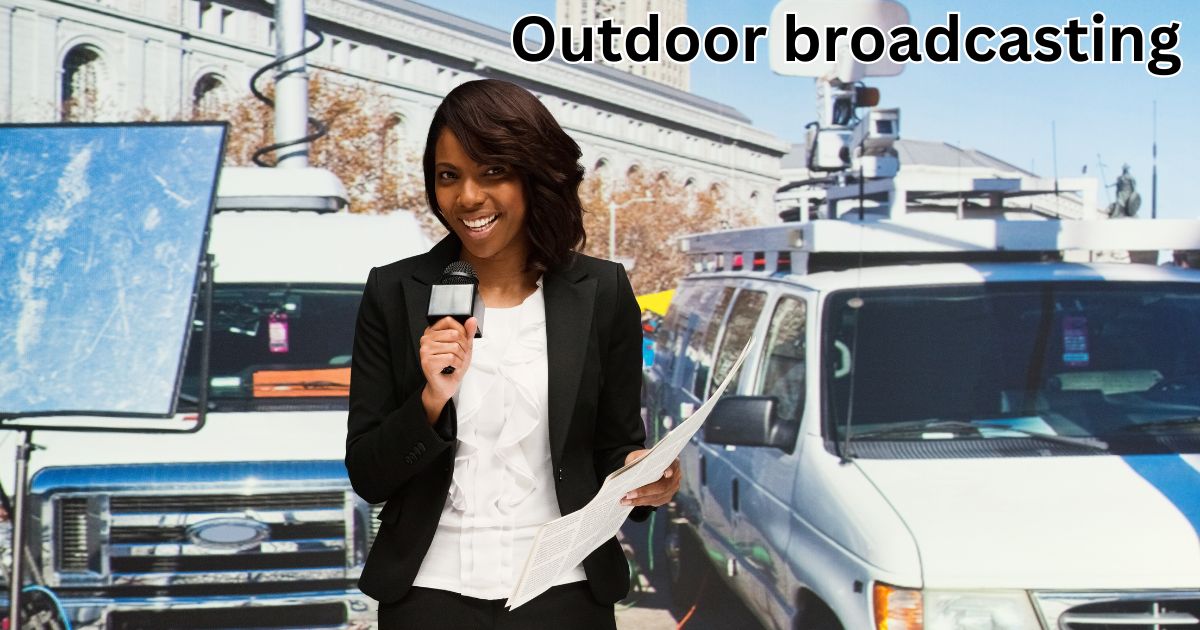Outdoor broadcasting, a dynamic facet of modern media, involves transmitting live audio and video content from locations outside traditional studio environments. This form of broadcasting is essential for delivering real-time coverage of events, capturing the authenticity and immediacy of live happenings. Whether it’s a major sporting event, breaking news, or a cultural festival, outdoor broadcasting brings audiences closer to the action, offering a vivid and unfiltered view of events as they unfold.
The importance of outdoor broadcasting cannot be overstated. It plays a crucial role in modern journalism, entertainment, and sports, enabling broadcasters to reach wide audiences with up-to-the-minute information and visuals. The ability to broadcast live from virtually any location has transformed the way we consume media, providing a more immersive and engaging experience for viewers. As technology continues to evolve, the scope and capabilities of outdoor broadcasting are expanding, making it an indispensable tool in the media industry.
History of Outdoor Broadcasting
The history of outdoor broadcasting dates back to the early 20th century, with the first significant milestone being the live radio broadcasts of sporting events and public speeches. These early broadcasts were limited by technology, but they laid the groundwork for the expansive field of outdoor broadcasting we see today. As technology advanced, so did the ability to broadcast from diverse and remote locations, culminating in the first televised outdoor broadcasts in the 1930s.
Technological advancements have played a pivotal role in the evolution of outdoor broadcasting. From the introduction of mobile broadcast units in the 1950s to the development of satellite transmission in the 1960s, each innovation has expanded the possibilities for live coverage. Key milestones include the first live satellite broadcast of the 1964 Tokyo Olympics and the widespread use of live broadcasting during the Apollo moon landings. These events not only showcased the potential of outdoor broadcasting but also cemented its place as a vital component of global media.
Types of Outdoor Broadcasting
Outdoor broadcasting encompasses various types, each serving a unique purpose. Live event coverage, such as concerts, parades, and political rallies, allows audiences to experience events in real-time, providing a sense of immediacy and excitement. These broadcasts capture the energy and atmosphere of the events, making viewers feel as though they are part of the action.
News reporting is another critical aspect of outdoor broadcasting. Journalists can report live from the scene of breaking news, offering firsthand accounts and visuals that are crucial for keeping the public informed. This type of broadcasting ensures that viewers receive accurate and timely information, enhancing the credibility and impact of news organizations.
Sports broadcasting is perhaps the most popular form of outdoor broadcasting. Live coverage of sporting events, from football matches to the Olympics, brings the thrill of the game directly to fans’ screens. These broadcasts not only provide play-by-play commentary but also include expert analysis, interviews, and behind-the-scenes content, enriching the viewer’s experience.
Cultural and entertainment events, such as music festivals, award shows, and theater performances, are also commonly broadcast live. These broadcasts allow audiences who cannot attend in person to enjoy the event from the comfort of their homes, expanding the reach and accessibility of cultural experiences.
Essential Equipment for Outdoor Broadcasting
Successful outdoor broadcasting requires a range of essential equipment to ensure high-quality audio and video transmission. Cameras and recording devices are the backbone of any broadcast, capturing visuals that are then transmitted to viewers. Modern outdoor broadcasting relies on high-definition (HD) and 4K cameras, which provide clear, detailed images even in challenging conditions.
Microphones and audio equipment are equally important, capturing clear and crisp sound to accompany the visuals. Various types of microphones, including handheld, lapel, and boom microphones, are used depending on the nature of the broadcast. Audio mixers and processors help ensure that the sound is balanced and free of interference.
Transmission and broadcast equipment are crucial for sending the captured audio and video signals to the audience. This includes satellite uplinks and downlinks, wireless transmitters, and mobile network solutions. These technologies enable broadcasters to transmit live content from virtually any location, ensuring that the broadcast reaches viewers without delay or interruption.
Reliable power supply solutions are essential for outdoor broadcasting, as events often take place in locations without readily available electricity. Portable generators, battery packs, and solar panels provide the necessary power to keep equipment running smoothly throughout the broadcast. Ensuring a stable power supply is critical to avoiding interruptions and maintaining the quality of the broadcast.
Outdoor Broadcasting Vehicles
Outdoor broadcasting vehicles, commonly known as OB vans, are mobile units equipped with all the necessary equipment for live broadcasting. These vehicles come in various types and sizes, ranging from small vans to large trucks, each designed to accommodate different broadcasting needs. They are an integral part of the outdoor broadcasting setup, providing a self-contained environment for production and transmission.
Broadcast vehicles are equipped with a range of features and capabilities, including multiple camera feeds, audio mixing consoles, and editing suites. They also house transmission equipment, such as satellite uplinks and wireless transmitters, enabling live broadcasts from remote locations. The mobility and versatility of these vehicles make them ideal for covering a wide range of events, from sports matches to news coverage.
The importance of outdoor broadcasting vehicles cannot be overstated. They provide a centralized hub for all broadcasting activities, ensuring that the production team can operate efficiently and effectively. These vehicles are designed to handle the rigors of outdoor broadcasting, with robust construction and advanced technology that ensure reliable performance in various conditions.
Setting Up for Outdoor Broadcasting
Setting up for outdoor broadcasting involves meticulous planning and preparation to ensure a smooth and successful broadcast. The first step is conducting a site survey and planning the logistics of the broadcast. This involves assessing the location, identifying potential challenges, and determining the best setup for cameras, microphones, and other equipment.
Equipment setup and configuration are crucial aspects of the process. Cameras need to be positioned to capture the best angles and views, while microphones must be placed to ensure clear and accurate audio. Technical crew members are responsible for configuring the equipment, ensuring that all components are properly connected and functioning as expected.
Ensuring reliable power sources is a critical consideration in outdoor broadcasting. Since many outdoor locations do not have readily available electricity, portable generators, battery packs, and other power solutions must be arranged. This step is essential to avoid interruptions and ensure that the broadcast runs smoothly from start to finish.
Challenges in Outdoor Broadcasting
Outdoor broadcasting presents a unique set of challenges that must be managed to ensure a successful broadcast. One of the primary challenges is dealing with weather and environmental conditions. Broadcasters must be prepared for rain, wind, extreme temperatures, and other weather-related factors that can impact the quality of the broadcast and the safety of the crew and equipment.
Technical issues and troubleshooting are common in outdoor broadcasting. Equipment malfunctions, signal interference, and connectivity problems can arise unexpectedly, requiring quick and effective solutions. Having a skilled technical team on hand is essential to address these issues promptly and minimize disruptions.
Logistics and transportation also pose significant challenges in outdoor broadcasting. Coordinating the movement of equipment, vehicles, and personnel to and from the broadcast location requires careful planning and execution. Ensuring that all necessary equipment is transported safely and set up correctly is crucial to the success of the broadcast.
Technical Aspects of Outdoor Broadcasting
The technical aspects of outdoor broadcasting involve complex processes and technologies that enable live transmission of audio and video content. Signal transmission methods are at the core of these processes, with options including satellite, microwave, and cellular networks. Each method has its advantages and limitations, and the choice depends on the location and requirements of the broadcast.
Satellite uplinks and downlinks are commonly used in outdoor broadcasting, especially for transmitting signals over long distances. These systems provide reliable and high-quality transmission, making them ideal for major events and remote locations. However, they require precise alignment and clear line-of-sight to the satellite, which can be challenging in some environments.
Wireless and mobile network solutions have become increasingly popular in outdoor broadcasting, offering greater flexibility and mobility. These solutions use cellular networks to transmit signals, allowing broadcasters to move freely and cover dynamic events. Advances in 4G and 5G technology have significantly improved the reliability and speed of these transmissions, making them a viable option for many outdoor broadcasts.
Roles and Responsibilities in an Outdoor Broadcast Team
An outdoor broadcast team consists of various roles and responsibilities, each contributing to the success of the broadcast. Producers and directors are responsible for overseeing the entire production, from planning and coordinating to managing the live broadcast. They make critical decisions on content, timing, and presentation, ensuring that the broadcast runs smoothly and meets the objectives.
Camera operators and technicians play a vital role in capturing high-quality visuals and ensuring that the equipment functions correctly. They are responsible for setting up and operating cameras, adjusting settings, and troubleshooting technical issues. Their expertise ensures that the visuals are clear, stable, and aligned with the broadcast requirements.
On-air talent and reporters are the faces and voices of the broadcast, providing commentary, interviews, and live updates. Their role is to engage the audience, deliver information, and maintain a dynamic presence throughout the broadcast. They work closely with producers and directors to ensure that their content aligns with the overall production.
Support and logistics personnel handle various tasks, including transportation, setup, and maintenance of equipment. They ensure that all components are in place and functioning correctly, providing essential support to the technical and production teams. Their efforts are crucial in managing the logistical aspects of outdoor broadcasting.
Safety Measures in Outdoor Broadcasting
Safety is a paramount concern in outdoor broadcasting, given the potential risks and challenges associated with operating in diverse and often unpredictable environments. Ensuring crew safety involves implementing comprehensive safety protocols and training. This includes using personal protective equipment (PPE), conducting regular safety briefings, and being prepared for emergencies.
Protecting equipment from damage is another critical aspect of safety in outdoor broadcasting. Equipment must be safeguarded against weather conditions, physical impacts, and other hazards. This involves using protective cases, covers, and securing equipment properly during transport and setup.
Dealing with emergencies requires having contingency plans in place. This includes having backup equipment, alternative power sources, and clear communication protocols. Being prepared for potential issues ensures that the broadcast can continue smoothly, even in the face of unexpected challenges.
Also Read: USDTCCK
Legal and Regulatory Considerations
Outdoor broadcasting involves navigating various legal and regulatory considerations to ensure compliance and avoid potential issues. Obtaining permits and licenses is a fundamental requirement, as many locations and events require official authorization for broadcasting. This process involves liaising with local authorities and event organizers to secure the necessary permissions.
Adhering to broadcast regulations is essential to ensure that the content and transmission methods meet the standards set by regulatory bodies. This includes complying with guidelines on content, signal transmission, and advertising. Failure to adhere to these regulations can result in fines, penalties, and potential disruptions to the broadcast.
Copyright and intellectual property issues are also important considerations in outdoor broadcasting. Broadcasters must ensure that they have the rights to use and transmit the content, including music, visuals, and other media. This involves securing permissions and licenses from content owners and adhering to copyright laws.
Innovations in Outdoor Broadcasting Technology
Technological innovations have revolutionized outdoor broadcasting, enhancing the quality and capabilities of live broadcasts. High-definition (HD) and 4K broadcasting have become standard, providing viewers with stunningly clear and detailed visuals. These advancements have significantly improved the viewing experience, making live broadcasts more engaging and immersive.
Drone technology and aerial coverage have opened up new possibilities for outdoor broadcasting. Drones can capture unique and dynamic aerial shots, providing perspectives that were previously unattainable. This technology is particularly valuable for covering large-scale events, sports, and natural disasters, offering viewers a comprehensive view of the scene.
Real-time data and graphics integration have become essential features of modern outdoor broadcasts. These technologies allow broadcasters to overlay live data, statistics, and graphics onto the video feed, enhancing the informational value of the broadcast. This is especially useful in sports broadcasting, where real-time statistics and analysis add depth to the coverage.
The Role of Social Media in Outdoor Broadcasting
Social media has transformed the landscape of outdoor broadcasting, providing new opportunities for engagement and interaction. Enhancing viewer engagement through social media involves using platforms like Facebook, Twitter, and Instagram to share live updates, behind-the-scenes content, and interactive features. This helps build a community around the broadcast, fostering a deeper connection with the audience.
Live streaming on social platforms has become a popular way to reach wider audiences. Broadcasters can stream live events directly to social media, allowing viewers to watch from anywhere with an internet connection. This increases the accessibility and reach of the broadcast, attracting more viewers and enhancing the overall impact.
Interactive features and audience participation are key elements of social media integration in outdoor broadcasting. Viewers can engage with the broadcast through comments, polls, and Q&A sessions, making the experience more interactive and personalized. This level of engagement helps create a more immersive and enjoyable viewing experience.
Case Studies of Successful Outdoor Broadcasts
Examining case studies of successful outdoor broadcasts provides valuable insights into best practices and innovative approaches. Major sporting events, such as the Olympics and World Cup, showcase the capabilities of outdoor broadcasting on a global scale. These events require extensive planning, coordination, and technical expertise to deliver high-quality live coverage to millions of viewers.
Breaking news coverage, such as natural disasters and political events, highlights the importance of outdoor broadcasting in delivering timely and accurate information. These broadcasts demonstrate the ability to quickly mobilize and provide real-time updates from the scene, keeping the public informed and engaged.
Large-scale cultural events, like music festivals and award shows, illustrate the power of outdoor broadcasting in bringing cultural experiences to a wider audience. These broadcasts capture the excitement and energy of the events, allowing viewers to enjoy performances and moments they might otherwise miss.
Training and Skill Development for Outdoor Broadcasting
Training and skill development are crucial for professionals in the field of outdoor broadcasting. Educational programs and courses provide foundational knowledge and technical skills needed for successful broadcasting. These programs cover various aspects of production, from camera operation to audio engineering, preparing individuals for the demands of the industry.
On-the-job training and workshops offer practical experience and hands-on learning opportunities. Working alongside experienced professionals allows trainees to develop their skills in real-world scenarios, gaining valuable insights and expertise. Workshops focused on specific technologies and techniques help broadcasters stay up-to-date with the latest advancements.
Certifications and professional development are essential for career advancement in outdoor broadcasting. Obtaining certifications from recognized organizations demonstrates proficiency and commitment to the field. Continuous professional development through workshops, seminars, and industry conferences helps broadcasters stay current with evolving trends and technologies.
Future Trends in Outdoor Broadcasting
The future of outdoor broadcasting is shaped by ongoing technological advancements and changing audience preferences. Advances in technology, such as 5G and beyond, are set to revolutionize the industry. Faster and more reliable network connections will enhance the quality and speed of live broadcasts, enabling more dynamic and immersive experiences.
Changing audience preferences are influencing the content and format of outdoor broadcasts. Viewers increasingly seek personalized and interactive experiences, driving broadcasters to adopt new technologies and approaches. The integration of virtual reality (VR) and augmented reality (AR) is expected to become more prevalent, offering immersive viewing experiences that go beyond traditional broadcasts.
The impact of 5G technology on outdoor broadcasting is significant, providing faster data transmission and lower latency. This technology enables broadcasters to deliver high-quality live content with minimal delay, enhancing the viewer experience. The increased bandwidth and reliability of 5G networks also support the use of advanced technologies like drones and real-time data integration.
Environmental Impact of Outdoor Broadcasting
The environmental impact of outdoor broadcasting is an important consideration, as the industry strives to reduce its carbon footprint and adopt sustainable practices. The carbon footprint of outdoor broadcasts is influenced by factors such as transportation, power consumption, and equipment use. Broadcasters are increasingly aware of the need to minimize their environmental impact and are taking steps to achieve this.
Eco-friendly equipment and practices are being adopted to reduce the environmental impact of outdoor broadcasting. This includes using energy-efficient cameras and lighting, as well as renewable energy sources like solar panels. Broadcasters are also implementing recycling and waste reduction measures to minimize their ecological footprint.
Industry initiatives for green broadcasting are driving efforts to promote sustainability. Organizations and industry bodies are developing guidelines and standards for environmentally responsible broadcasting practices. These initiatives encourage broadcasters to adopt sustainable technologies and practices, contributing to a greener and more sustainable industry.
Budgeting and Cost Management in Outdoor Broadcasting
Budgeting and cost management are critical aspects of planning and executing outdoor broadcasts. Effective planning and allocating resources ensure that all necessary components are covered within the budget. This includes costs for equipment, personnel, transportation, and other logistical elements.
Cost-saving strategies help broadcasters manage expenses and optimize their budgets. This may involve renting equipment instead of purchasing, using local resources to reduce transportation costs, and negotiating favorable rates with vendors. Efficient resource management and careful planning are key to minimizing costs without compromising the quality of the broadcast.
Funding and sponsorship opportunities play a significant role in supporting outdoor broadcasts. Broadcasters often collaborate with sponsors and partners to secure financial support for their projects. This involves developing compelling proposals and demonstrating the value of the broadcast to potential sponsors.
Viewer Experience in Outdoor Broadcasting
Enhancing the viewer experience is a primary goal of outdoor broadcasting. High-quality visual and audio content is essential to engage and retain viewers. This involves using advanced cameras, microphones, and audio equipment to deliver clear and immersive broadcasts.
Interactive and immersive technologies are increasingly used to enhance the viewer experience. Virtual reality (VR), augmented reality (AR), and interactive graphics provide new ways for viewers to engage with the content. These technologies offer personalized and immersive experiences that go beyond traditional viewing.
Audience feedback and analysis are crucial for understanding viewer preferences and improving broadcasts. Broadcasters use various tools and techniques to gather feedback, including surveys, social media interactions, and viewership data. Analyzing this feedback helps identify areas for improvement and tailor content to meet audience needs.
Conclusion
The landscape of outdoor broadcasting is continually evolving, driven by technological advancements and changing audience preferences. The importance of innovation and adaptation cannot be overstated, as broadcasters strive to deliver high-quality, engaging, and immersive content to their audiences. The future of outdoor broadcasting holds exciting possibilities, with new technologies and approaches set to transform the industry.
As the field continues to grow and evolve, broadcasters must stay informed and adaptable, embracing new trends and technologies. The ability to deliver real-time, high-quality coverage of events is a testament to the power and potential of outdoor broadcasting. By continuing to innovate and adapt, the industry will remain a vital and dynamic component of the modern media landscape.









